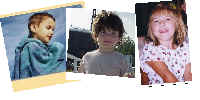|
Our HH Family Rebecca Faulkner |
|
Rebecca was born on Her condition
deterioated rapidly in the latter half of 1999, when she was having gelastic seizures
lasting On 24 November
1999 she became the fifth child to undergo HH surgery at Melbourne's She has been
seizure-free Rebecca's
favourite tv show is "Touched By an Angel". |
Rebecca - 3 years after surgery
Rebecca’s story We first noticed something strange when Rebecca was two years old, in late 1991. On numerous occasions she would suddenly stop what she was doing and stare into the distance for a few seconds. After a few of these episodes we consulted a district nurse who suggested Rebecca might be craving attention prior to the birth of her baby brother. Then, in May 1992, Rebecca was sitting on her potty when her eyes rolled back and turned to the right. Despite our frantic attempts, we could not communicate with her. She was unresponsive for at least a minute. We rushed her to hospital where after a variety of tests she was diagnosed with epilepsy. An EEG conducted at the time showed abnormalities in both temporal lobes, but a CT scan and a MRI revealed nothing unusual (although a MRI carried out 4 years later found evidence of a hypothalamic hamartoma which apparently was overlooked in the first MRI). We were told that no cause could be found for her epilepsy and that she may (or may not) grow out of her condition. Rebecca was first prescribed Tegretol, which did little for seizure control. Indeed within three weeks Rebecca was experiencing more severe seizures. These involved her head turning to one side, the twitching and jerking of her face, arms and/or legs and periods of unconsciousness lasting up to 5 minutes. By July 1992, Rebecca was experiencing multiple (severe) seizures on a daily basis and her neurologist introduced Sodium Valproate (Epilum) to her regime (Tegretol was subsequently ceased and Rebecca did not experience a "major seizure" after December 1992). From 1993 to 1999 Rebecca's seizures were typically rather short in nature (lasting between 5 and 45 seconds). They were characterised by a blank stare, a nervous giggle, watery eyes and dilated pupils. The muscles on the right side of her face would often contract and she had a loss of knowledge of her surroundings (she would often say "I don't know where I am" or "I feel funny"). On average Rebecca had between 2 and 6 of these seizures per day, however on two occasions Rebecca experienced between 50 and 100 minor seizures per day, resulting in her hospitalisation. Apart from her daily seizures Rebecca had poor gross motor control. She would often fall when running and she had great difficulty hopping and skipping. Rebecca also used to tire easily, often resulting in poor concentration and restlessness. She would struggle to read a book and was unable to recognise words, despite having already read the same words previously on the same page. In Maths she could not complete tasks that required multiple steps, as she would forget what she had done in earlier stages. Concerned with her scholastic progress and poor seizure control, we consulted another neurologist in 1996. This led to another MRI and the revelation of the hypothalamic hamartoma – the diagnosis: gelastic (or “laughing” epilepsy). We were told that hypothalamic hamartomas were benign brain tumours, probably formed in the sixth or seventh week of gestation. The tumours cause victims to have gelastic (laughing) seizures, sometimes tonic-clonic and drop seizures, "hypothalamic rage" behavioral problems, and frequently precocious (early) puberty. We were told this condition was very rare, that it was notoriously difficult to treat (being highly resistant to medications), and there was a good chance that Rebecca’s condition might worsen as she grew older. Surgery was also considered too risky at that time. Between July 1996 and early 1999, Rebecca's condition was relatively stable. She would average between 2 and 6 gelastic seizures every day, and (very occasionally) might have a seizure-free day. We tried a variety of medications to supplement her Epilum, including Frisium (caused drowsiness), Sabril (increased seizures), Lamictal (caused rash) and finally Neurontin. However from mid 1999 things worsened considerably. Her small giggles turned into loud screeches and she would throw her arms and legs around during a seizure. On some days the gelastic episodes were lasting up to three hours, whilst on other days she would have seizures every 20 minutes or so. By late 1999 Rebecca could no longer attend school or play sport. Thankfully early in 1999 our local neurologist, Dr Michael Harbord, informed us of a neurosurgeon in Melbourne, Australia, who had developed a pioneering surgical technique to remove hypothalamic hamartomas. In May 1999 we travelled to Melbourne for a series of tests and assessments. Within a few weeks of returning home we were informed that Rebecca would be considered a candidate for surgery. This began a long and difficult period where we weighed up the significant risks associated with surgery (from hormonal disturbances, stroke and death) against the potential benefits for Rebecca’s quality of life. As it turned out, given Rebecca’s rapid deterioration in late 1999, the decision was virtually made for us. For Rebecca’s sake – for her future – we had to proceed with surgery. In November of that year we travelled to the Royal Children’s Hospital where under the guidance of Dr Simon Harvey, Director of the Children’s Epilepsy Program, Rebecca was admitted for surgery. Rebecca became Professor Jeffrey Rosenfeld's fifth HH surgical case on 24 November 1999 and has remained seizure-free ever since. She has been off all epileptic medications since February 2000. We have noticed a remarkable transformation in our daughter since surgery. We will forever be grateful to Prof Rosenfeld, Dr Harvey and the wonderful medical staff at the RCH.
|

